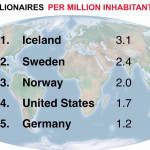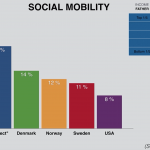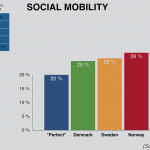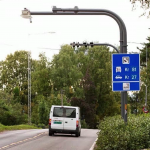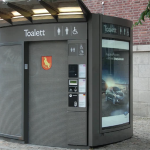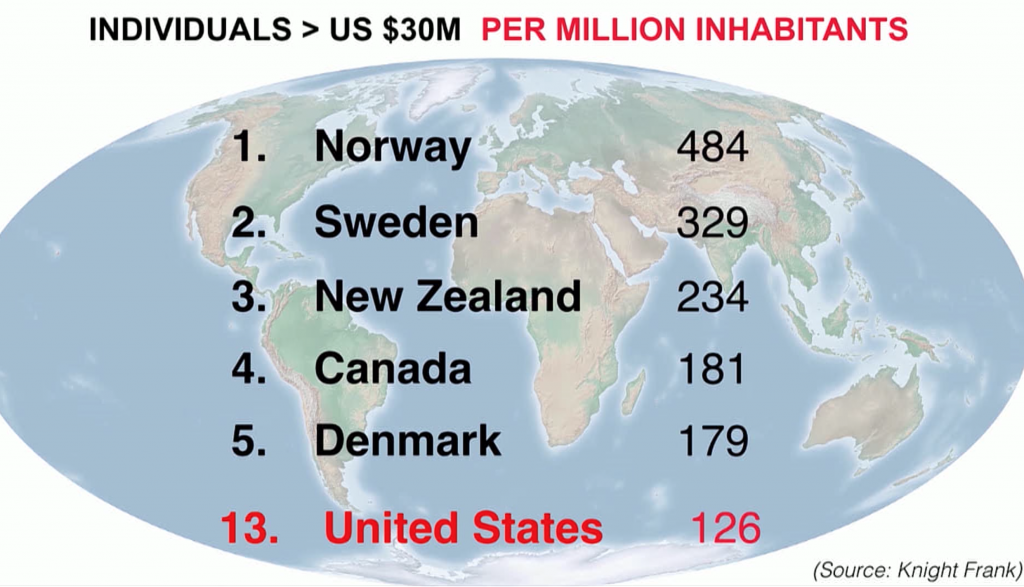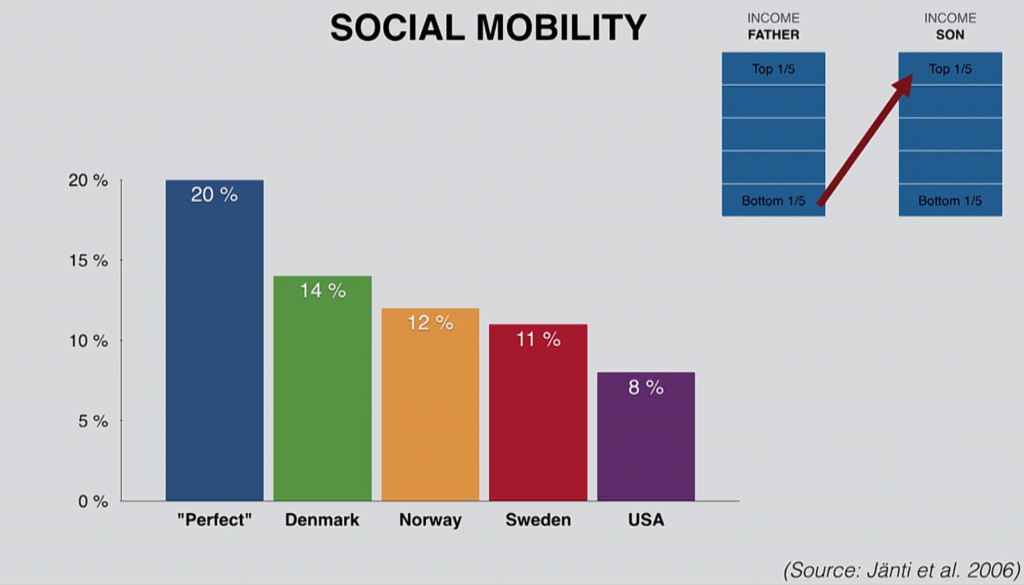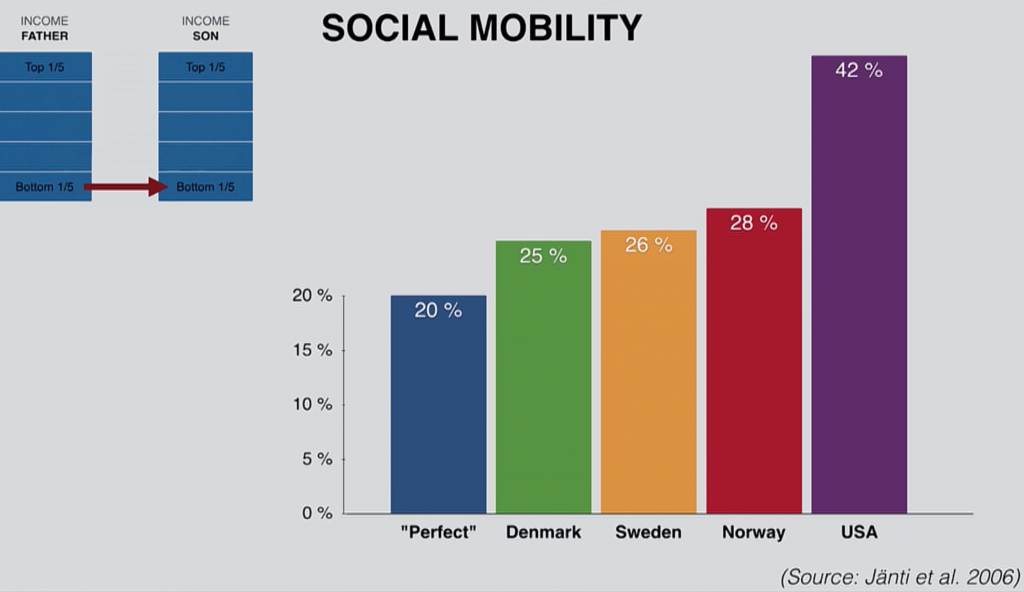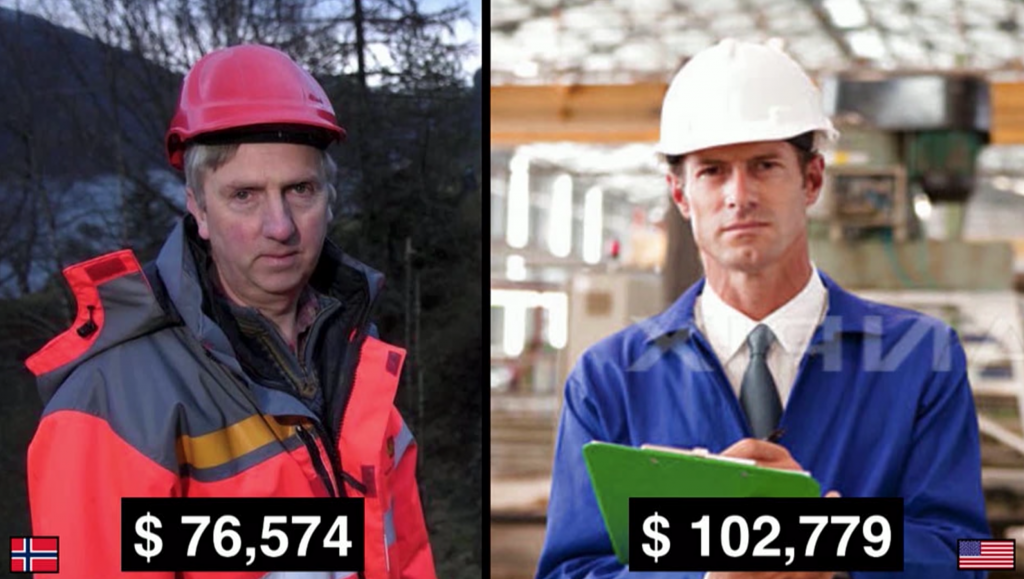Transcript of Harald Eia’s talk at TEDxOslo.
Where in the world is it easiest to get rich?
That’s the question I asked my professor when I studied sociology in the early ‘90s, because he was having a lecture about social democracies, Scandinavian welfare state, and he was a classical left-wing sociology professor. And he could not hide his enthusiasm when he talked about these egalitarian societies with no rich people and no poor people.
But I, on the other hand, I was writing my master thesis about rich people. So when I interviewed my informants from the upper classes, they all said the same thing: life in Scandinavia is tough. We have to work twice as hard to earn money, because we have to struggle against high taxes, strong unions controlling the wages and a generous welfare state that makes people lazy. As one rich guy told me, he said they call it a social security net. Well, I call it hammock.
And as every aspiring social scientists, I had — starting to go native, I started to feel sympathy for these rich people. And that’s why I raised my hand and asked my professor: well, what if you don’t care so much about equality, what if your dream is to become rich, where in the world should I have been born to become really rich?
I still remember the puzzled look on my professor’s face but he answered the best he could, something like, “Well, if that’s your goal in life, you should probably have been born in a society with free markets, low taxes, and minimal government intervention. And that if you want to become rich, you should probably not study sociology.”
And that was a good answer and the best guess we had back then, that is until I visited the Professor of Economics Kalle Moene at the University of Oslo who actually had checked the facts and answered the question: where in the world is it easiest to get rich?
And before I share with you where you should go to earn money, we have to define rich. The UN talks about the poverty line, you know, if you earn less than $1 a day, maybe $2 a day, but we have to define the richness line, it’s a more fun line actually. And the most reliable report when it comes to rich people, The Wealth Report (2014), sets the richness line at individuals with net worth more than $30 million. In the consultant jargon, these people are called UHNWs, that is ultra-high-net worth individuals.
So according to The Wealth Report, there are more than 170,000 UHNWs in the world and here’s the top five list of countries with most rich people. Number five, China with more than 8,000; UK, Germany, Japan, and on top of course United States with more than 40,000 rich people.
But of course, we’re not interested in the absolute numbers here. We are interested in rich people per capita per million inhabitants. And if we leave out the pure tax havens, like Cyprus and Switzerland, Hong Kong, Singapore, Monaco, who have an artificially huge share of rich people, it turns out that we have on number five Denmark with 179 rich people per million inhabitants; Canada, New Zealand, Sweden, and on top Norway.
But where’s the US? On place 13. So what happened to my old professor’s idea that “there are no rich people in social democracies”? But okay, $30 million, that’s pocket money in a country like the US where people can get insanely rich.
So let’s raise the richness line up from $30 million up to $1 billion. And the most reliable source here is the Forbes Billionaires List and according to the Forbes, if you look at billionaires per million inhabitants, on number five, Germany 1.2 billionaires per million inhabitants; United States 1.7, Norway 2, Sweden 2.4, and on top Iceland with 3.1, with a single billionaire Thor Bjorgolfsson.
The big mystery is how can this be: how can Bernie Sanders’ dream societies, socialist paradises, be such a breeding place for rich people? That’s a mystery.
There are two reasons. Reason number one is free education. Social democracies give free higher education to everybody – cheap student loans and grants enables more people to use their talents and earn money. We can see this in the social mobility numbers. Imagine all fathers in a society and we divide them into five groups based on income from the bottom fifth up to the top fifth. And then we look at their sons and then divide their income into five groups, and we see how many sons of the fathers from the bottom income end up on top, how many sons go from rags to riches?
If it was perfect social mobility, if the talents and opportunities were equally distributed, 20% from the bottom would end up on each of these five ladders. So let’s look at the numbers for the different countries. In Denmark, they’re pretty close to perfect social mobility with 14%, going from rags to riches; in Norway 12%, Sweden 11%, United States 8%. Because of free education there are more self-made men in Scandinavia than in the US.
And if we look at those sons who don’t end up on top but stay on the bottom, go from rags to rags. Again 20% will be perfect mobility, in Denmark 25% ends up on the bottom. This is because education in United States is very expensive.
But the second and most important explanation for Scandinavia being such a breeding place for rich people is this: have you ever noticed if you’ve been to the United States when you drive through a toll plaza, there’s actually people sitting there taking your money. Compare that to my local toll plaza, just a sign with some gizmo attached to it.
And when you go to a supermarket in the United States there are actually people there helping pack your things into your bags. It’s very friendly and convenient compared to my local grocery store, like this. Nobody there.
And the biggest shock I had when I went to the US for the first time and went to the restroom there are actually people working there. Compare that to my local public toilet, there’s not even a cleaner there. It cleans itself automatically.
And the reason for this difference is that Scandinavian unions are pressing up the minimum wages, so it’s so expensive to have these people working there. In Norway tollbooth operator, supermarket packers and a restroom janitor would earn almost three times as much as in the US. And that’s why we have replaced these people with machines.
And that is why I was surprised when I saw an article in The New York Times in 2014 titled “preparing for chip and PIN cards in the United States”, because in the United States people are still using paper checks as a method of payment while Scandinavian banks have made us start using chip and PIN cards long ago, because the minimum wages here are so high. So Scandinavian banks can’t afford having people manually controlling the checks. So Scandinavian companies, because of the unions pressing up the wages, they had to downsize and introduce new technology or else they will go broke. And new technology increases the productivity in a society which in the long run also increases profit.
And on the upper end of the wage ladder, in the name of solidarity, Scandinavian unions hold back the highest salaries of the skilled workers. So, for example, a Norwegian senior engineer earns on average per year $76,000, while his American colleague earns more than $100,000. So American engineers — they are not only better good-looking but they are more expensive.
So the unions are in effect subsidizing the capitalists. I wish I knew all this when I gave up a career in social science because the beauty and the irony of this finding, I think, is amazing. On the one hand, you have my rich informants that complain about how hard it is to get rich in Scandinavia and they had it all wrong. Not only is it easier to get rich in a social democracy but they are critical to the very institutions that have helped them getting rich: high taxes, which gives free education and more talent into the economy, strong unions that are helping increasing the productivity, and the generous welfare state that make the unions accept downsizing because they know that their members will be well taken care of, so the unions cooperate because of the safety net.
Get Evonomics in your inbox
So rich people are a bit like Immanuel Kant’s famous bird who thinks she could fly even faster in air-less space, forgetting that it’s the air itself that gives her lift.
And on the other part of the political spectrum when Bernie Sanders is praising Scandinavian societies, he forgets that these are not anti-rich or anti-capitalist systems, because the welfare state and unions work in tandem with capitalist dynamics. And I think that is the most important lesson here.
The economy is not a zero-sum game. We’re in this together, and that is why Scandinavia is a better place to fulfill the American dream. Thank you so much.
2018 August 11
Donating = Changing Economics. And Changing the World.
Evonomics is free, it’s a labor of love, and it's an expense. We spend hundreds of hours and lots of dollars each month creating, curating, and promoting content that drives the next evolution of economics. If you're like us — if you think there’s a key leverage point here for making the world a better place — please consider donating. We’ll use your donation to deliver even more game-changing content, and to spread the word about that content to influential thinkers far and wide.
MONTHLY DONATION
$3 / month
$7 / month
$10 / month
$25 / month
You can also become a one-time patron with a single donation in any amount.
If you liked this article, you'll also like these other Evonomics articles...
BE INVOLVED
We welcome you to take part in the next evolution of economics. Sign up now to be kept in the loop!
























